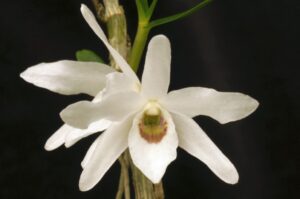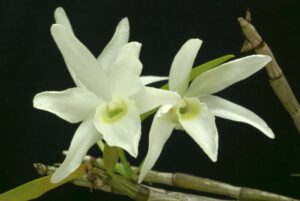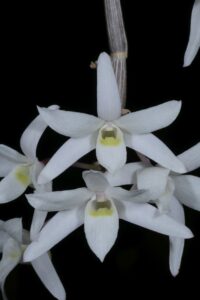The following article was written for the Orchid Species Bulletin published by the Orchid Species Society, which is based in Brisbane, Queensland in March 2003, and updated in March 2025.
Bear in mind that any cultivation notes refer to the subtropical conditions of Southern Queensland, Australia.

Dendrobium moniliforme
Dendrobium moniliforme (L.) Sw. is the type species for the genus Dendrobium. Carl Linnaeus first described this taxon as Epidendrum moniliforme, in Species Plantarum in 1753. Olof Swartz transferred it to his new genus Dendrobium in Nova Acta Regiae Societatis Scientiarum Upsaliensis in 1799. The specific epithet comes from the Latin moniliformis (moniliform, jointed or constricted at regular intervals, so as to resemble a string of beads), referring to the multi-node pseudobulbs.
Den. moniliforme is a highly variable species, both in plant habit and flower form. It is an epiphytic or sometimes lithophytic plant, which produces clustered, erect or pendent, multi-node stems that are 5-25 (-45) cm long, and 3-5 mm diameter. The pseudobulbs are purplish-green, and are covered with sheaths that become dry and grey, after the leaves fall. When old and leafless, the pseudobulbs become yellow. Each pseudobulb bears two-ranked, narrowly lanceolate, alternating leaves, at 2-3.5 cm intervals along the length. The mid-green to dark green leaves are 4-6 (-8) cm long, and 6-10 mm broad, and they are usually deciduous, after the first season.

Dendrobium moniliforme
Very short inflorescences from the upper nodes, along the matured, usually leafless pseudobulbs, bear 1-2 (rarely 3) starry flowers that usually open widely, and are 2-4.5 cm across. Very fragrant, the flowers of Den. moniliforme are usually pure white, with the column-foot and disc of the lip greenish-yellow to olive-green. The disc has a narrow transverse band of red to brown spots, and the underside of the column is scattered with dense purple-red spots. Rarely are the flowers flushed with pink or pale rose throughout, as in f. roseum. Short-lived, the flowers last for about 5-7 days, and may last longer during the cooler months. Charles and Margaret Baker (1996) indicate that the blossoms are relatively long-lasting; and Bill Lavarack et al. (2000) say that they last about 2-3 weeks. Flowering occurs mainly in spring, with sporadic blooms produced from winter to summer.

Dendrobium moniliforme
Select cultivars of Den. moniliforme are highly prized in Japan, Korea and Taiwan. I have been told that some of them may cost as much as a small Japanese house! These cultivars may be variegated plants (f. variegatum) with yellow or white stripes on the leaves; plants with red-purple colour in the leaves; short, plants with stubby-stems or knobbly growths; have very long thin stems; or twisted or rounded leaves. Some cultivars may have very small flowers or flowers that do not open very widely; very broad petals; sepals, petals and lip margined with pink; or prominent red-brown markings on the disc.
Den. moniliforme is one of the numerous Dendrobium species, that is widely collected for use in Traditional Chinese Medicine. After the stems are dried, they are boiled for use.
Distributed in Japan, the Ryukyu Islands, southern Korea, China and Taiwan, Den. moniliforme is found growing on slightly shaded rocks, and on tree trunks or branches, in broadleaf forests, between 800-2,500 m altitudes.
An intermediate to cool-growing species, Den. moniliforme requires good air circulation at all times. It is best cultivated in a small pot or basket, with a well-drained medium. Take care not to over-pot, by using a container that is just large enough to contain the root system. Alternatively, it can be mounted on tree fern, cork bark or hardwood but may need daily watering or misting during the summer months. Cultivate it under 50-70% shade, and keep the roots moist while it is in active growth. Provide it with a cooler, drier rest in winter, with occasional watering in the morning on sunny days, to prevent the pseudobulbs from shrivelling. Plants should not be allowed to remain dry for long periods, even in winter. I recommend a winter minimum of 10 ⁰C. However, plants will tolerate much lower temperatures down to 4-5 ⁰C if they are dry at night.
References:
Baker, M.L. & C.O. Baker. (1996) Orchid Species Culture – Dendrobium. Timber Press, Portland, Oregon.
Bechtel, H., Cribb, P. & E. Launert. (1992) The Manual of Cultivated Orchid Species. 3rd ed. Blandford Press, London.
Chen, S., Tsi, Z. & Y. Luo. (1999) Native Orchids of China in Colour. Science Press, Beijing.
Garay, L.A. & H.R. Sweet. (1974) Orchids of Southern Ryukyu Islands. Botanical Museum, Harvard University, Cambridge, Massachusetts.
Lavarack, P.S., Harris, W. & Stocker, G. (2000) Dendrobium and its Relatives. Kangaroo Press, East Roseville, N.S.W.
Lin, T.-P. (1975) Native Orchids of Taiwan – Vol. 1. Southern Materials Center, Taipei.
Stearn, W.T. (1983) Botanical Latin. 3rd ed. David & Charles Inc. Vermont, USA.
Su, H.-J. (1985) Native Orchids of Taiwan. 3rd edition. Harvest Farm Magazine, Taipei.
Ying, S-S. (1977) Coloured Illustrations of Indigenous Orchids of Taiwan. National Taiwan University, Taipei, Taiwan.
